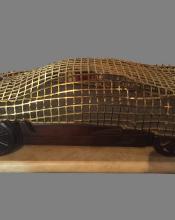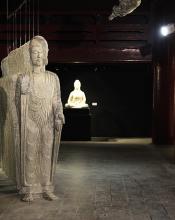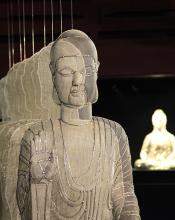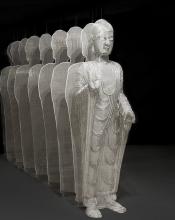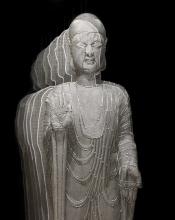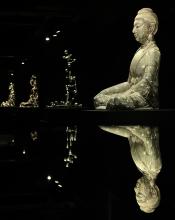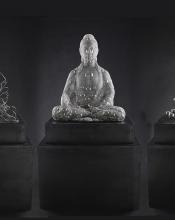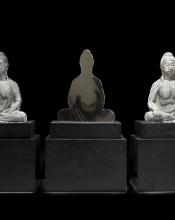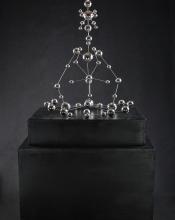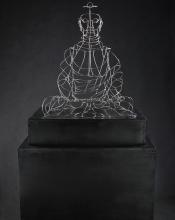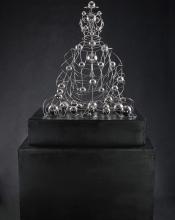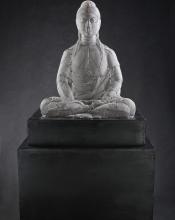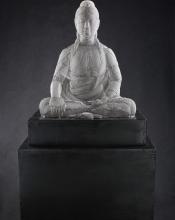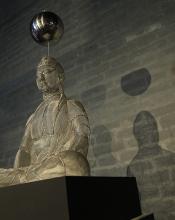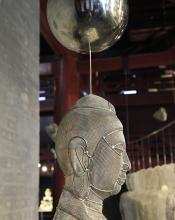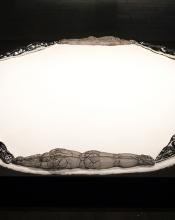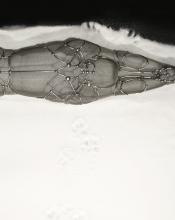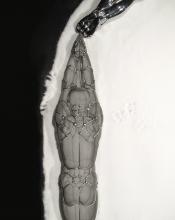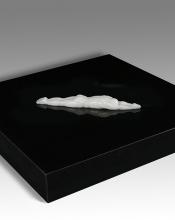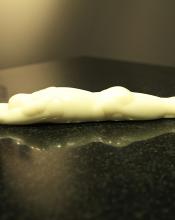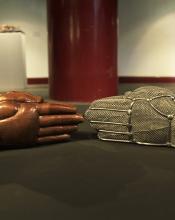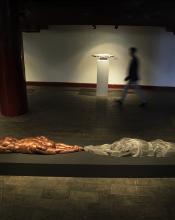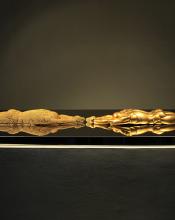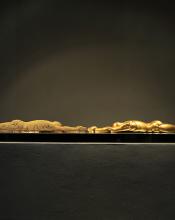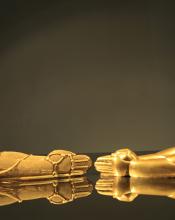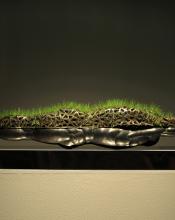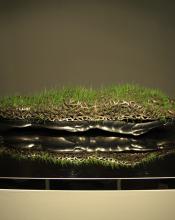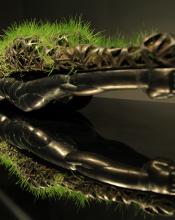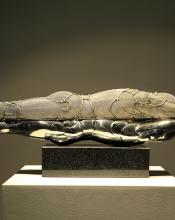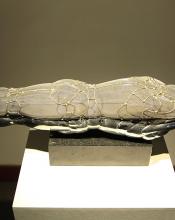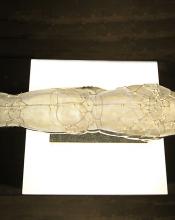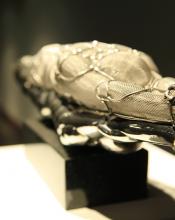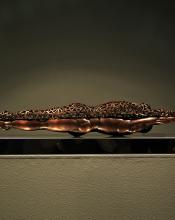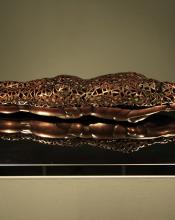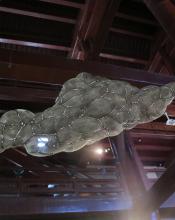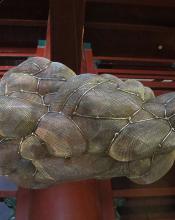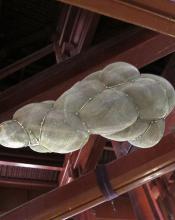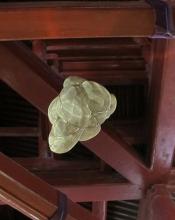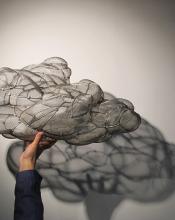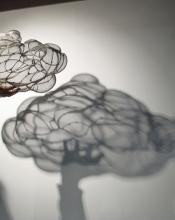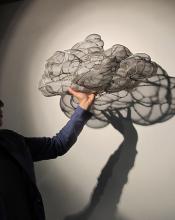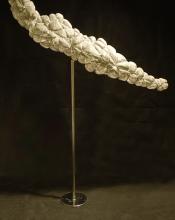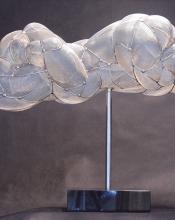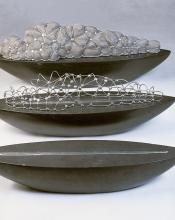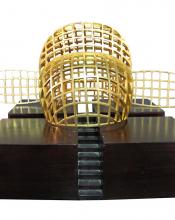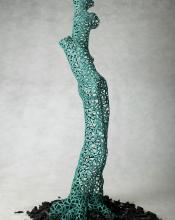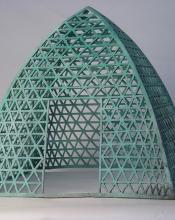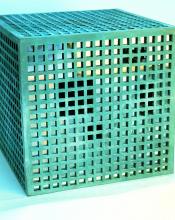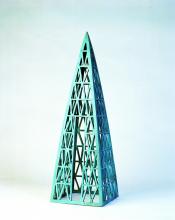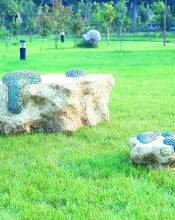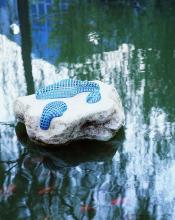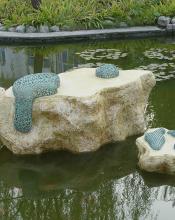Shi Zhongying
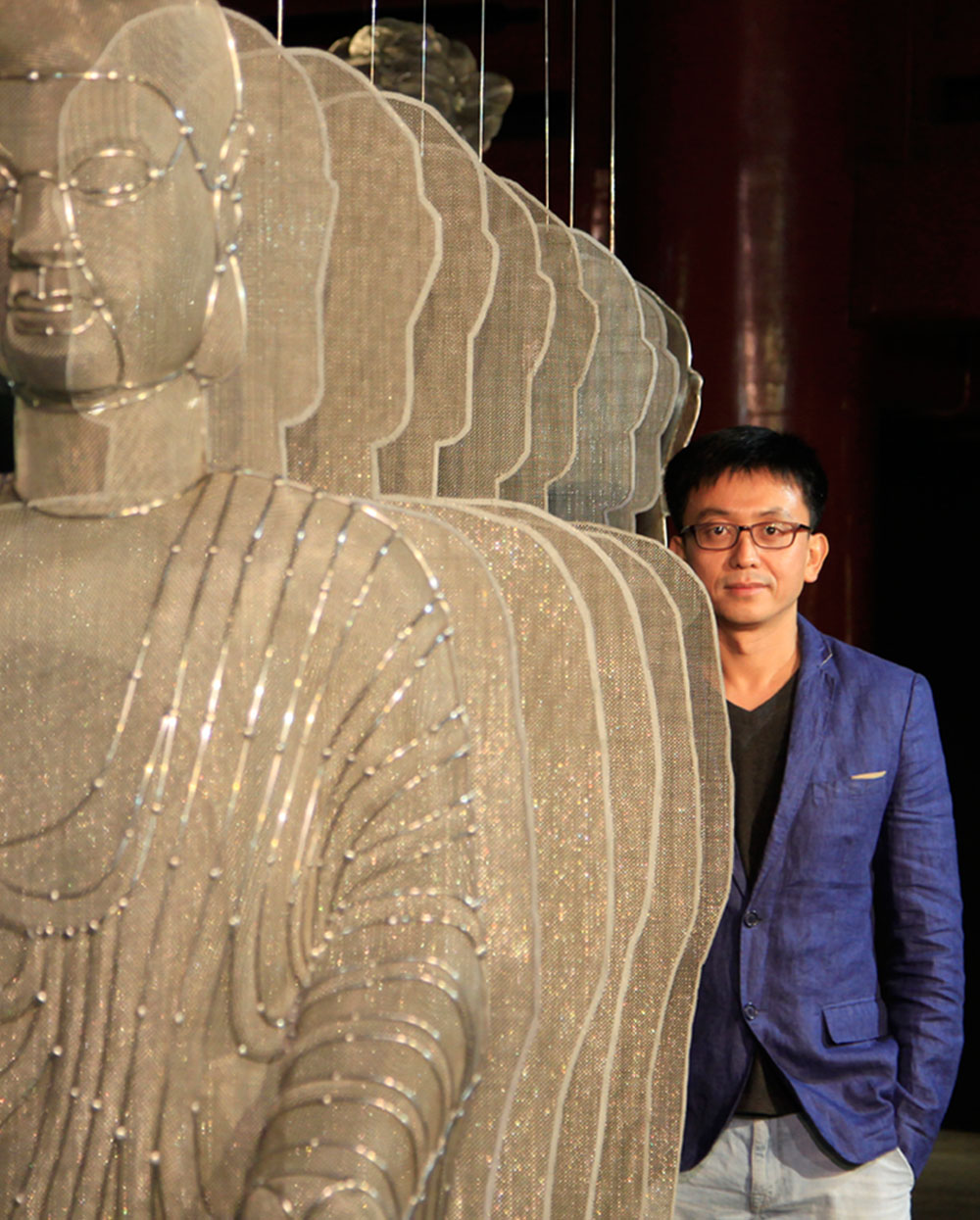
-------------------------
Zhongying’s Icons: Shi Zhongying's Contemporary Sculpture
Exhibition Venue: The Opposite House
Exhibition Dates: 1st January – 31st March, 2015
Essay: Viewing Zhongying’s Icons
Since ancient times, makers of Buddha statues and Buddhist icons have rarely bequeathed their names to posterity or left traces of their lives. There are two major reasons for this situation: First, the ancient Chinese did not have the concept of “the arts” (yishu) that we borrowed in modern times from the West, and those artisan sculptors who relied on time-honored craft practices were relegated by the “articulate” to the ranks of craftsmen who vanished among the anonymous mass of the population. Second, those who crafted statuary were discrete in their “self-identity as artists”, either because they consigned their work to those who commissioned them or because their work was motivated by religious piety, and so they tended to be obscured by society or by religious appearances, and were not visible to most people.
At other times, he delicately traces the sensual curves of a vine or a nautilus shell. All of his forms embody the idea of complex balance that is central to Buddhism and indeed to the universe itself.
This exhibition includes Zhongying’s Buddha Icon series and his Self series. The Buddhas and the Selves are installed together and so reflect each other. The works use different materials that are carved and cast, then augmented and completed, some even with plants and soil. Thus they appear to transform in the process of seeking balance, and this balance in the works gives them a “harmonious and tranquil style”, yet not simple harmonizing, rather metaphysical speculation and an atmosphere that is at one and the same time constructed by harmony, alienation (distancing), development, and change, and this forms the moving heart of the exhibition.
How does he achieve this? In the context of contemporary sculpture, critics and the market demand that many works consciously or unconsciously embody elements that are “weird” and “volatile” to elicit a dramatic reaction in viewers the moment they see it, but the aesthetic reaction is short-lived and gives way to ennui. So many sculptures are able to arouse dramatic emotions but this hides a poverty and inadequacy of underlying content; it is all part of the mad drive to be different in the quest for fame. The works of a few young artists who have reacted against this trend to “weirdness” and “volatility” have appeal because of their freshness and purity, but works such as Zhongying’s that achieve an “evenly balanced and tranquil style” are rare among contemporary sculptures.
I have known Shi Zhongying for many years; his mild temperament and simple manner, and the persistence he brings to his creative work, give him a unique style. At all times, there is a Buddhist coloring in what he says and he is not at all flashy like other people imagine. So, I can confirm that apart from the fact that he and his creative work do not emerge from some fundamentalist mysticism, yet I am always curious to know whether religion for him is a home, or a path? Did his mild temperament and emotional makeup find an inner compatibility with Buddhism or did the teachings of the Dharma gradually lead him to tranquility? From the perspective of an observer such questions come alive when contemplating the man and his work in the context of this exhibition.
And so I was looking for answers in the exhibition.
Shi Zhongying, talking about his Buddha Icon series, has said: “My initial motivation in creating this series of works was tackling the question of how I use contemporary art forms to convey my understanding of Buddhist wisdom and at the same time remove from these Buddha icons any traces of the notion of idolatry and superstition that Buddhist images often evoke in the minds of many people, especially intellectuals, and so position Buddhist sculptural art and contemporary society in a truly meaningful relationship”. In his works we can see that in the arrangement of the serene background of the work titled Buddhas of the Past, Present and Future, the lighting creates the metamorphosis from figurative image to abstraction, from entity to void, and finally “from form to meaning”, and the expressed imagery of this entire process is also a process in which the iconic existence of the “Buddha” is deconstructed; this process of deconstruction acts on inherent rules and beliefs. What most interests me is how in this process of deconstruction the artist removes forms and the remaining traces of images that all call for subjective choices, because behind these choices lies something spontaneous that invariably reveals his true self.
The viewer sees how wherever the mesh body of the central Buddha is restrained and supported by wire, the form has a subtle fullness in the interplay between the void and reality, endowing it with stylistic perfection; the Buddhas to either side have been removed from their “flesh-and-blood” embodiment, and the most “pleasing” aspect is that only the framework remains in the void. Even so, the attentive viewer will have no trouble discerning the structural proportions of the frame of the body and the textured white cloth retains the icons’ inner harmony and elegance. While this could be interpreted as the artist intentionally extracting the essence of the Dharma, I believe this is more the result of Shi Zhongying’s many years of academic training in perfecting sculptural modeling and his technical self-cultivation. In this way, his particular choices and his finely honed talent and ideas are not attributable to religious philosophy and thought, but to his natural expression as an artist.
In another work titled Amitabha, Shi Zhongying attempts to treat his personal sculptural language as an installation, and in the imagistic and spatial relationships of reality and void that infuse the Buddha icon, he opens up a mode of “transformative incarnation” that ushers the viewer into an observational process informed by alternative perspectives, in which images enervated at the boundaries of images and space generate ideas and through the blurred boundaries of religious and artistic ontology we can glimpse the individuation of the self through the haze.
In the artistic language Shi Zhongying deploys in this exhibition, Buddhist themes occupy the absolutely central position, but the viewer can everywhere discern the “self”, particularly in the Self series. These works take as their blueprint the genuflecting and extended postures of the Tibetan Buddhist pilgrim, and these combine different media to present a deep meditation on issues related to the Buddha and the Self. Shi Zhongying has said: “Buddhists have a deep understanding of the Self, and the self does not simply refer to a person’s body (the corporeal self) but has a much broader meaning referring to the subjective selfness and independently unchanging existence of everything, and the conclusion that to grasp the self one can only be free by liberating oneself. Prostrating oneself in the pilgrimage mode of Tibetan Buddhism is to put aside all arrogance, to abandon the Ego completely, and to embody humility; it is a misconception to see such a Buddhist practice as an expression of idolatry. Yet this group of works is not cloaked in ordinary Tibetan Buddhist robes; I have used my own body as the prototype for emphasizing first-hand experience, and I use the most basic sculptural body language to provide a concise metaphor of the primordial state of the self”.
But as a viewer, I not only see the “Self” of the experiential understanding of the artist in this group of works, but also see the relations and reflections generated between the “Self” and external objects. Regardless of their title, in the work titled The Floating Life the white marble “Self” floats in the quietude of the black granite; in Rebirth the purity of the eight Selves is highlighted by the scattered salt; in Symbiosis the grass that sprouts from the body of the Self is ongoing life. All these works can be seen as the quest of the inner self for inner balance and seeking oneness and harmony with the external world, as well as the effort to adapt and understand.
After I left the exhibition, I continued to ponder the “self” that is Shi Zhongying the individual and his works, and the question of whether religion for him is a home, or a path? At its core, his art is an interpretation of the Dharma, and he borrows the Dharma to find his own path of artistic development, or does he use this complex synthesis of realities to preserve his own inner calm? I still cannot answer this question, but perhaps the question is irrelevant because causality is irrelevant, and do religion and art ultimately make this distinction?
Liu Guan, Beijing
October 31, 2014
Translated by Dr Bruce Doar
-------------------------
Viewing Emptiness
Exhibition Venue: Red Gate Gallery
Exhibition Dates: July, 2007
Essay: Shi Zhongying’s Contemporary Buddhist Aesthetic
Aside from the philosophical power and spiritual energy that Shi has imbued in his works, there is undeniable grace and lyricism.
In discussions of his own approach to his work, Shi Zhongying emphasizes his understanding of symbolism and metaphor. Invoking Jungian archetypes, he manipulates media and form to develop a visual language for Buddhist philosophies. While there is a powerful sense of revelation in his work, there remains an element of searching. The crisp formal qualities imply clarity for complex metaphysical concepts. Simultaneously, there are the ever-present notions of experimentation and approximation. With each answer, solution and resolution Shi Zhongying deftly supplies, he attaches a question, a problem and a conflict. The resulting visual and sensual balance contributes to the overarching notion of the creation of a contemporary Buddhist aesthetic.
Form is nearly always the key aspect in any work of art, but Shi Zhongying seems to take the notion of form to a higher level. His careful (and remarkably patient) explorations of the formal elements of sculpture and painting appear initially to dominate the subject matter and purpose of his creations. After further consideration, the complex structuring and geometric rigour reveal themselves to be mere stepping-stones to a meditation on and exploration of spatial relationships. The investigations of the spatial relationships that Shi presents embody the metaphors for metaphysical concepts the viewer is invited to contemplate.
Shi’s comprehensive approach is self-evident in his installations. Often the viewer is confronted with a sculpture in tandem with an oil painting of the same sculpture. The artist presents the two together and lights them meticulously to create further manifestations in the forms of shadows. Close examination of the oil paintings reveal thin, fuzzy ribbons of darkness around the painted subject matter; Shi reminds us that the real life shadows we see had cousins in his studio, and he asks us to consider the relationship between the old shadows’ footprints in his paintings and the freshly created shadows emblazoned before us in the gallery. He uses these forms to provide perspectives on complex inter-relationships, and he asks us to ponder the difference between an actual shadow and its simulacrum.
Adding to his works’ philosophical impact, Shi designs his installations to be viewed from different perspectives. In doing so, the artist underscores the importance of transitions. Transitions hold great importance in Buddhist thought. They are thought to carry intense spiritual potential, and alertness and awareness during transitional moments offer the keys to understanding reality. Shi often presents us with subjects that seem to be frozen in a moment in time, or (perhaps more accurately) he has slowed down the transition for us so that we may achieve some visual and spiritual clarity through observation.
Our own movement and examination elaborates on the transitions and puts them back into motion at a pace we can determine and thus comfortably follow.
The emphasis on metaphysical transition informs Shi’s selection of media and form. The sturdiness and purity of stainless steel give us the sense that the sculptural medium is the ‘control’ in the experiment: we can trust its static qualities. To emphasize dynamic elements and clarify our perspective, Shi gives us the rigid geometry of the grid in many instances. The insistent regularity of this pattern makes slight variation conspicuous, as on a two-dimensional topographical map. Any warp or bulge is highlighted in this format, and Shi makes it easy for us to see how different his works look from different angles and in different lighting.
At other times, he delicately traces the sensual curves of a vine or a nautilus shell. All of his forms embody the idea of complex balance that is central to Buddhism and indeed to the universe itself.
Tally Beck
July, 2007
at Red Gate Gallery
-------------------------
|
1975 |
Born in Yuannan |
|
1999 |
Graduated from the Sculpture Dept.,Central Academy of Fine Arts,Beijing |
|
1999 - 2004 |
Teacher at the Academy of Fine Arts, Hebei University |
|
2004 – 2007 2007- Present: |
Masters Degree in the Sculpture Department, CAFA Professor of Art and Design at the Beijing Forestry University |
|
Solo Exhibitions 2019 Mutual Generation in Rheology, ODRADEK Gallery, Brussels |
|
|
2015 |
Abandonment & Symbiosis, Kunting Experimental Art, Beijing |
|
|
Zhongying’s Icons, The Opposite House, Beijing |
|
2014 |
Zhongying’s Icons, Red Gate Gallery |
|
2007 2005 2005 |
Viewing Emptiness, Red Gate Gallery Viewing Space, Red Gate Gallery Philosophy Space, Green Tea House |
|
Group Exhibitions
|
|
|
2022
2021 2020 2018
2017 |
Countdown Series 2, Red Gate Gallery Future?, Red Gate Gallery Memory Wall – Red Gate Gallery 30th Anniversary, Red Gate Gallery Backlighting, Red Gate Gallery Difference: 2018 China Datong Sculpture, China Sculpture Museum, Shanxi 5th Word Buddhist Forum, Putian Art Museum, Fujian The Secret Garden, Guantang Art District, Beijing Red Gate on the Move, Red Gate Gallery |
|
|
The 7th Beijing International Art Biennale China 2017,National Art Museum of China, Beijing |
|
2016 |
Flower in the Rock, Beijing 22 International Art Plaza |
|
|
Bustling Glimmer, Beijing Agricultural Exhibition Centre |
|
|
Breathing – Contemporary Sculpture in Traditional Chinese Culture, Nanjing Museum, Nanjing |
|
2015 |
Tanyuan International Sculpture Biennial 2015, Taiyuan Art Museum |
|
|
Seoul International Sculpture Exhibition, Seoul Arts Center, Seoul |
|
|
2nd Chinese Contemporary Buddhist Exhibition, Wuxi Soul Mountain Fanonhouse, Wuxi |
|
|
A Beautiful Mind, Longyibang Gallery, Beijing |
|
|
6th China Koran Contemporary Sculpture Exchange Exhibition, Chian Sculpture Institute, Beijing |
|
2014 |
Hand in Hand – 2014 1st Sculpture Exhibition of China Open, National Tennis Centre, Beijing |
|
|
Innovation – Artistic conception, Chaoyang Museum of Urban Planning, Beijing |
|
|
2nd Suzhou Jinji Lake Biennale, Suzhou |
|
|
Approaching the public, Beijing 22 International Art Plaza, Beijing |
|
|
New Year Celebration Paintings,National Art Museum of China, Beijing |
|
2013 |
10th China Art Festival Exhibition, Shandong Art Museum, Shan Dong |
|
|
Pilgrimage - National Fine Arts,Dunhuang Art Museum, Dunhuang |
|
|
Flying ! Language ! - 3rd Sculpture Exhibition,National Centre for the Performing Arts, Beijing |
|
2012 |
Chinese Pose – The 2nd China sculpture Tour |
|
|
Sculpt China – CAFA Sculpture Retrospective, The Sculpture Institute of the CAFA, Beijing |
|
|
Two Generations - 20 Years of Chinese Contemporary Art Australian Tour: City of Sydney Chinese New Year; Manning Regional Gallery; Damien Minton Gallery; University of Newcastle Gallery; Melbourne International Fine Arts (MiFA); Linton & Kay, Perth |
|
2011 |
20 Years - Two Generations of Artists at Red Gate, island6 Art Center, Shanghai |
|
|
20 Years - Two Generations of Artists at Red Gate, Red Gate Gallery |
|
|
Luxembourg Ambassador’s Sculpture Garden, Beijing |
|
|
Ming to Nirvana, Red Gate Gallery |
|
2009 |
China Form, Red Gate Gallery |
|
|
11th National Art Exhibition, Changchun |
|
|
1st Sculpture Exhibition, Beijing, Changchun |
|
2008 |
Future Sky – Nominated Chinese Contemporary Young Artists |
|
|
Today Art Museum |
|
|
Present Situation – Annual Nominated Sculpture Exhibition of Liu Haisu |
|
|
Museum, Shanghai |
|
|
Red Gate Stars, Red Gate Gallery |
|
|
1st China Grand Exhibition of Sculptures, Tour Exhibition |
|
2007 |
Neo-Nirvana Contemporary Interpretations of Buddhism, 798 / Red Gate Gallery |
|
2006 |
To the Watchtower: Red Gate Gallery’s 15th Anniversary, Red Gate Gallery |
|
|
Starting from Sculpture, Beijng |
|
|
China – Korea Contemporary Sculpture, Beijing |
|
|
China – Korea Contemporary Sculpture, 798 / Beijing |
|
2005
|
Luxury Time – Sculpture Prediction Contemporary Outdoor Sculpture of China, Tanjin 2nd Beijing International Art Biennial, National Art Museum of China |
|
|
(NAMOC) |
|
|
Asian Traffic, Today Art Museum, Beijing |
|
|
2nd Chengdu Biennial, Chengdu |
|
2004 |
10th National Art Exhibition, NAMOC |
|
|
1st Fresco Exhibition, NAMOC |
|
2003 |
1st Beijing International Art Biennial, NAMOC |
|
|
1st Guilin Yuzi Paradise International Sculpture Awards, Guilin Yuzi |
|
|
Paradise, Guangxi |
|
2002 |
Beijing International City Sculpture, Beijing International Sculpture Garden |
|
|
Beijing Dialogue, China Art and Archive Warehouse; Embassy of Norway, |
|
|
Beijing |
|
2001 |
1st Jingwen Art Exhibition, Jingwen Art Center, Shanghai |
|
|
Chinese Contemporary Art, Limn Gallery, San Francisco |
|
|
Clues to the Future - Red Gate Gallery’s 10th Anniversary, Red Gate Gallery |
|
|
Red Hot, Sponsored by Ogilvy and Mather, Red Gate Gallery |
|
|
Elements, Five Artists Metal Sculpture, CAFA; Red Gate Gallery |
|
2000 |
Conflicting and Choosing, 2nd Contemporary Young Sculptors Invitational, |
|
|
Hangzhou; Qingdao |
|
1999 |
9th National Art Exhibition, NAMOC |
|
1998 |
Country of Pottery, China Contemporary Pottery, Spain; Denmark; |
|
|
England |
|
|
97 - 98 International Biological Sculpture Competition, Italy |
|
1997 |
Six Young Urban Sculptors, Tianjin |
|
Awards |
|
|
2003 |
Excellence Prize, 1st Guilin Yuzi Paradise International Sculpture |
|
2002 |
Excellence Prize, Beijing International City Sculpture |
|
1999 |
Second Prize, The Okamatsu Foundation, CAFA |
|
Collections
|
|
Ministry of Culture, China; Peano Foundation, Italy; Embassy of Norway, Beijing; Beijing |
|
International Sculpture Garden; CAFA Gallery; Guilin Yuzi Paradise; Art Museum of |
|
Chengdu and Individual Collections |
-------------------------
Zhongying’s Icons: Shi Zhongying's Contemporary Sculpture
Exhibition Venue: Red Gate Gallery
Exhibition Dates: 18 October – 30 November, 2014
Autobiographical Note:
To be a sculptor, especially these days, I believe you must have a varied background in reserve as well as insight, apart from having an unwavering concept of your own personal values. It is not necessary that each and every one of these insights and background experiences be rationally deployed, but I do believe they remain in our subconscious, and if the opportunity arises they will surface and inspire wisdom in us.
Sculpture for me was one such important opportunity that, in turn, shaped me. Since 1999, I’ve been mainly working on using various types of grids as my main material to produce symbolic abstract shapes that I use to convey metaphysical meanings. But during the first two or three years I didn’t realize that my works contained Zen Buddhist meanings, and it was only as a result of conversations with friends and teachers that my curiosity was aroused and I began to learn about Buddhism and Buddhist studies and especially about its religious and philosophical thought. For me the resonance of great wisdom, especially that of Buddhism, had a most profound effect, and its great ideas in turn deeply influenced and inspired my sculpture, my outlook on life, and my values.
Even more exciting for me was the continuation of opposite and complementary growth. After one has produced a work that had as its inspiration a particular understanding then this work will not only lead to a series of new works but, what is more interesting, in the process of sharing the work with others, it takes on many new interpretations, and many of these go far beyond what originally motivated me to create the piece originally. Some of the interpretations and feedback I receive give further inspiration. For this I can thank both my audience and my sculpture!
The Buddha Series
In the propagation of Buddhism, Buddhist art forms change with the changing times.
The Self Series
The Self is a series of works that I have been trying to create over recent years, and each piece can be seen as a different stage and different understanding of what I am producing, as well as a contingency impelling me towards wisdom. Buddhists have a very deep understanding of “the self”, which not only refers to the physical “self” but in a more generalized sense refers to everything that exists independently as a self-aware subject, with the result that if one cannot detach oneself from “the self” then one cannot be free from attachment. In Tibetan Buddhism pilgrims who measure out their journeys in long full-body prostrations encapsulate the humility that is necessary for casting aside arrogance and completely abandoning the “self”, and it is a general misconception that this Buddhist practice entails kowtowing before idols.
The true meaning of Buddhism’s stress on “emptiness” (vacuity) does not mean that there is nothing, but that the things of nature do not have a subjectivity that is independent and constant; there is nothing that is constant and unvarying, so there is no “Self” and everything is relative and transient, and can only be understood as part of a constant and interdependent evolutionary flow.
Shi Zhongying, Beijing
October, 2014
Translated by Dr Bruce Gordon Doar
-------------------------

